Primary Health Care: Addressing Aged Care Understaffing Challenges
VerifiedAdded on 2023/01/11
|8
|1906
|73
Report
AI Summary
This report examines the critical issue of understaffing in aged care facilities, highlighting its origins in the deregulation of the Aged Care Act 1997 and the resulting impact on patient care quality. It discusses the decrease in resident-to-staff ratios, leading to inadequate care, increased risk of falls and pressure sores, and nurse burnout. The report explores arguments for and against deregulation, along with the financial and political implications of potential solutions. The proposed recommendation involves reintroducing resident-to-staff ratios to ensure adequate care, despite potential increased costs. The report considers the benefits of improved patient care and nurse work-life balance, while acknowledging the risk of staff interactions over patient care. Implementation involves recruiting more nurses, requiring government and healthcare authority funding, and navigating legislative steps. Communication strategies are outlined to raise awareness and support the proposed changes. The references provides the sources used in the report.
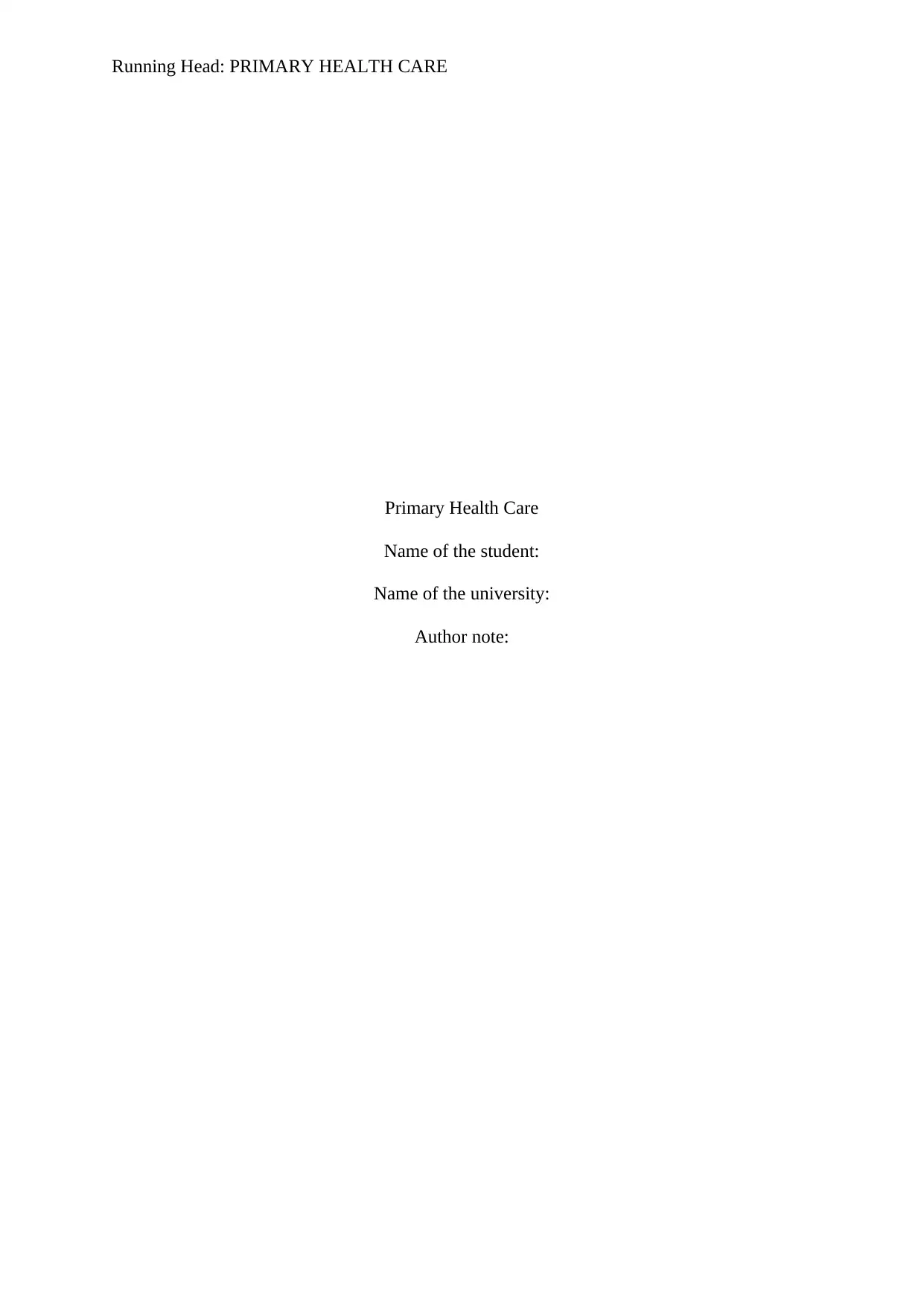
Running Head: PRIMARY HEALTH CARE
Primary Health Care
Name of the student:
Name of the university:
Author note:
Primary Health Care
Name of the student:
Name of the university:
Author note:
Paraphrase This Document
Need a fresh take? Get an instant paraphrase of this document with our AI Paraphraser
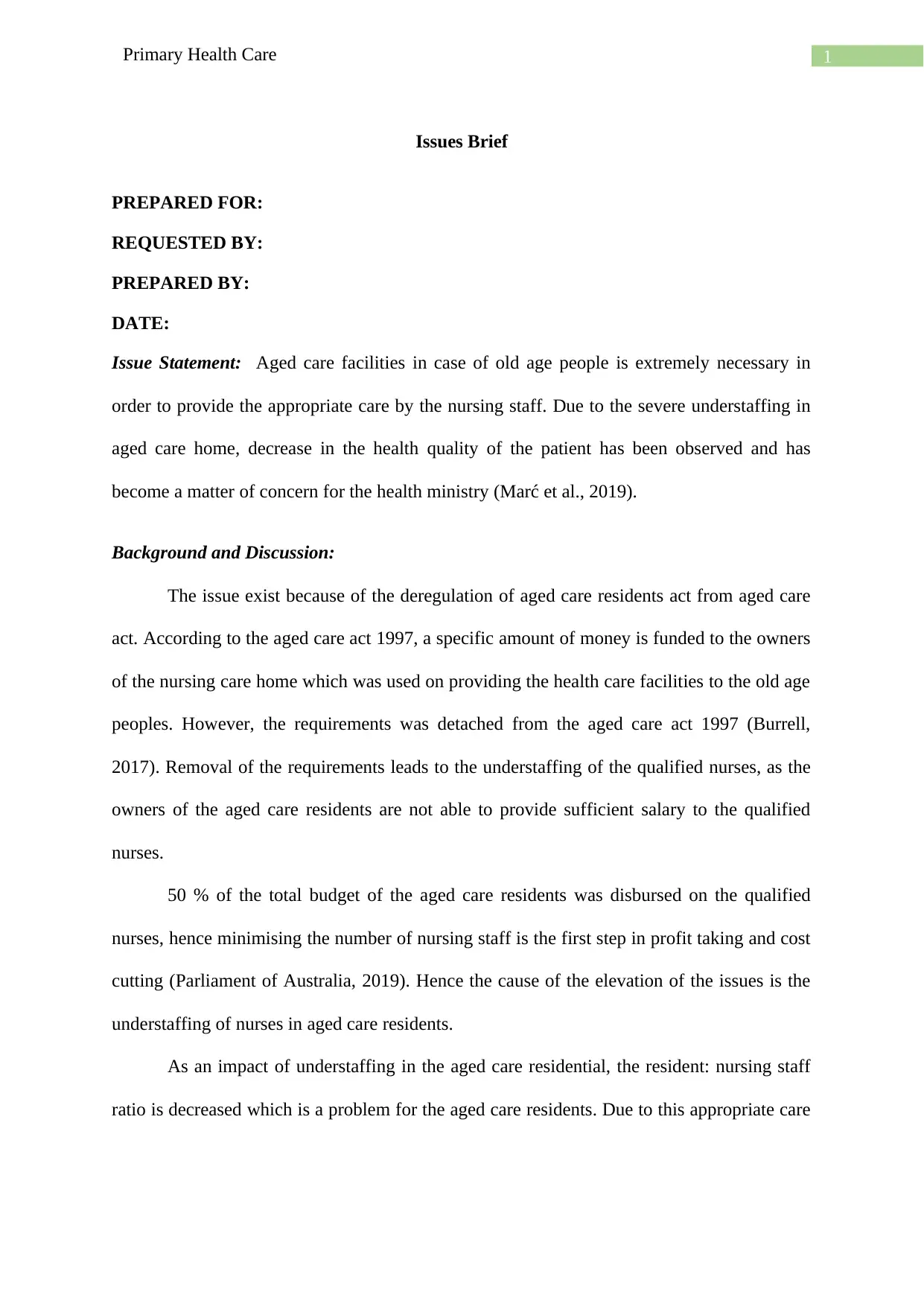
1Primary Health Care
Issues Brief
PREPARED FOR:
REQUESTED BY:
PREPARED BY:
DATE:
Issue Statement: Aged care facilities in case of old age people is extremely necessary in
order to provide the appropriate care by the nursing staff. Due to the severe understaffing in
aged care home, decrease in the health quality of the patient has been observed and has
become a matter of concern for the health ministry (Marć et al., 2019).
Background and Discussion:
The issue exist because of the deregulation of aged care residents act from aged care
act. According to the aged care act 1997, a specific amount of money is funded to the owners
of the nursing care home which was used on providing the health care facilities to the old age
peoples. However, the requirements was detached from the aged care act 1997 (Burrell,
2017). Removal of the requirements leads to the understaffing of the qualified nurses, as the
owners of the aged care residents are not able to provide sufficient salary to the qualified
nurses.
50 % of the total budget of the aged care residents was disbursed on the qualified
nurses, hence minimising the number of nursing staff is the first step in profit taking and cost
cutting (Parliament of Australia, 2019). Hence the cause of the elevation of the issues is the
understaffing of nurses in aged care residents.
As an impact of understaffing in the aged care residential, the resident: nursing staff
ratio is decreased which is a problem for the aged care residents. Due to this appropriate care
Issues Brief
PREPARED FOR:
REQUESTED BY:
PREPARED BY:
DATE:
Issue Statement: Aged care facilities in case of old age people is extremely necessary in
order to provide the appropriate care by the nursing staff. Due to the severe understaffing in
aged care home, decrease in the health quality of the patient has been observed and has
become a matter of concern for the health ministry (Marć et al., 2019).
Background and Discussion:
The issue exist because of the deregulation of aged care residents act from aged care
act. According to the aged care act 1997, a specific amount of money is funded to the owners
of the nursing care home which was used on providing the health care facilities to the old age
peoples. However, the requirements was detached from the aged care act 1997 (Burrell,
2017). Removal of the requirements leads to the understaffing of the qualified nurses, as the
owners of the aged care residents are not able to provide sufficient salary to the qualified
nurses.
50 % of the total budget of the aged care residents was disbursed on the qualified
nurses, hence minimising the number of nursing staff is the first step in profit taking and cost
cutting (Parliament of Australia, 2019). Hence the cause of the elevation of the issues is the
understaffing of nurses in aged care residents.
As an impact of understaffing in the aged care residential, the resident: nursing staff
ratio is decreased which is a problem for the aged care residents. Due to this appropriate care
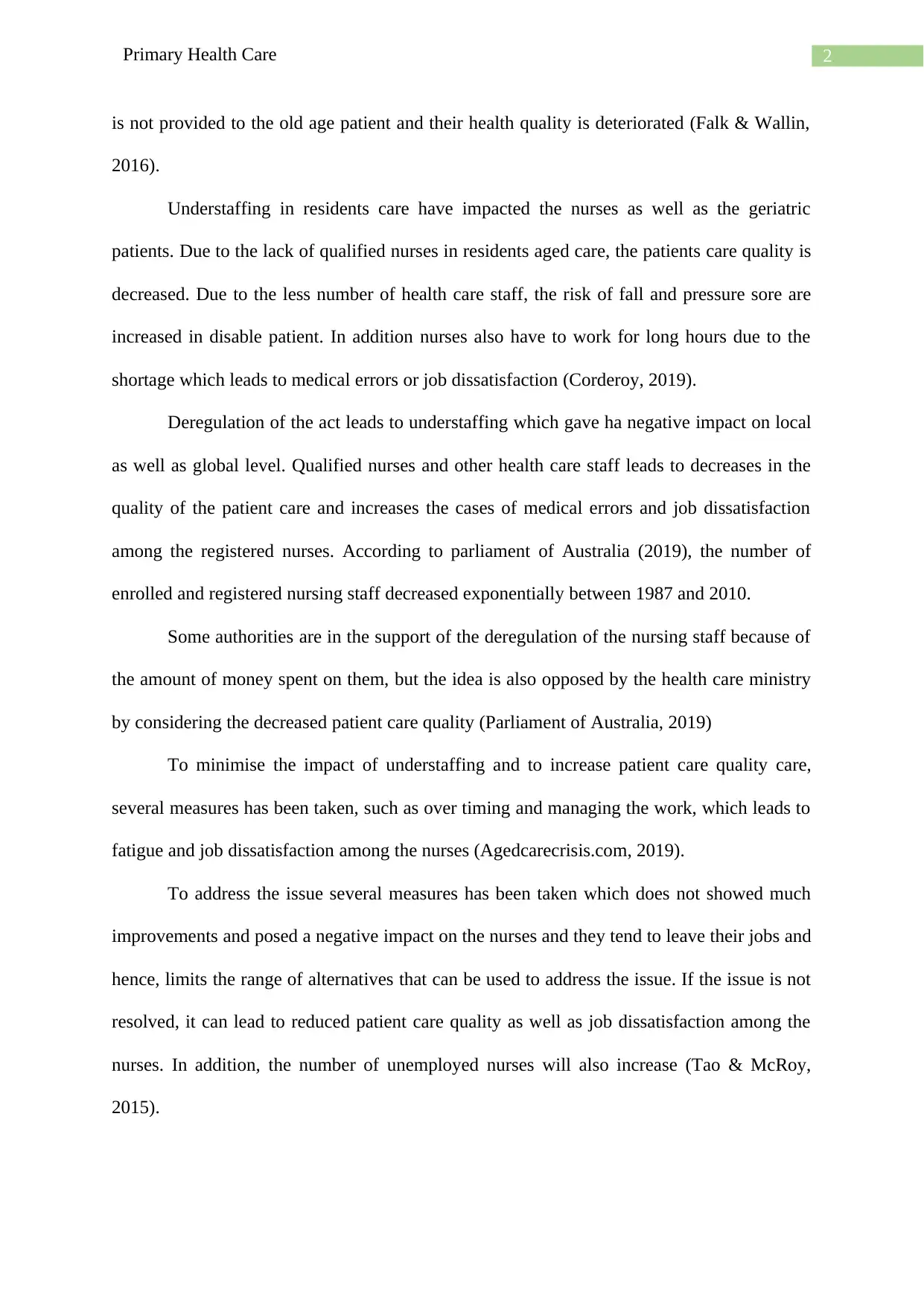
2Primary Health Care
is not provided to the old age patient and their health quality is deteriorated (Falk & Wallin,
2016).
Understaffing in residents care have impacted the nurses as well as the geriatric
patients. Due to the lack of qualified nurses in residents aged care, the patients care quality is
decreased. Due to the less number of health care staff, the risk of fall and pressure sore are
increased in disable patient. In addition nurses also have to work for long hours due to the
shortage which leads to medical errors or job dissatisfaction (Corderoy, 2019).
Deregulation of the act leads to understaffing which gave ha negative impact on local
as well as global level. Qualified nurses and other health care staff leads to decreases in the
quality of the patient care and increases the cases of medical errors and job dissatisfaction
among the registered nurses. According to parliament of Australia (2019), the number of
enrolled and registered nursing staff decreased exponentially between 1987 and 2010.
Some authorities are in the support of the deregulation of the nursing staff because of
the amount of money spent on them, but the idea is also opposed by the health care ministry
by considering the decreased patient care quality (Parliament of Australia, 2019)
To minimise the impact of understaffing and to increase patient care quality care,
several measures has been taken, such as over timing and managing the work, which leads to
fatigue and job dissatisfaction among the nurses (Agedcarecrisis.com, 2019).
To address the issue several measures has been taken which does not showed much
improvements and posed a negative impact on the nurses and they tend to leave their jobs and
hence, limits the range of alternatives that can be used to address the issue. If the issue is not
resolved, it can lead to reduced patient care quality as well as job dissatisfaction among the
nurses. In addition, the number of unemployed nurses will also increase (Tao & McRoy,
2015).
is not provided to the old age patient and their health quality is deteriorated (Falk & Wallin,
2016).
Understaffing in residents care have impacted the nurses as well as the geriatric
patients. Due to the lack of qualified nurses in residents aged care, the patients care quality is
decreased. Due to the less number of health care staff, the risk of fall and pressure sore are
increased in disable patient. In addition nurses also have to work for long hours due to the
shortage which leads to medical errors or job dissatisfaction (Corderoy, 2019).
Deregulation of the act leads to understaffing which gave ha negative impact on local
as well as global level. Qualified nurses and other health care staff leads to decreases in the
quality of the patient care and increases the cases of medical errors and job dissatisfaction
among the registered nurses. According to parliament of Australia (2019), the number of
enrolled and registered nursing staff decreased exponentially between 1987 and 2010.
Some authorities are in the support of the deregulation of the nursing staff because of
the amount of money spent on them, but the idea is also opposed by the health care ministry
by considering the decreased patient care quality (Parliament of Australia, 2019)
To minimise the impact of understaffing and to increase patient care quality care,
several measures has been taken, such as over timing and managing the work, which leads to
fatigue and job dissatisfaction among the nurses (Agedcarecrisis.com, 2019).
To address the issue several measures has been taken which does not showed much
improvements and posed a negative impact on the nurses and they tend to leave their jobs and
hence, limits the range of alternatives that can be used to address the issue. If the issue is not
resolved, it can lead to reduced patient care quality as well as job dissatisfaction among the
nurses. In addition, the number of unemployed nurses will also increase (Tao & McRoy,
2015).
⊘ This is a preview!⊘
Do you want full access?
Subscribe today to unlock all pages.

Trusted by 1+ million students worldwide
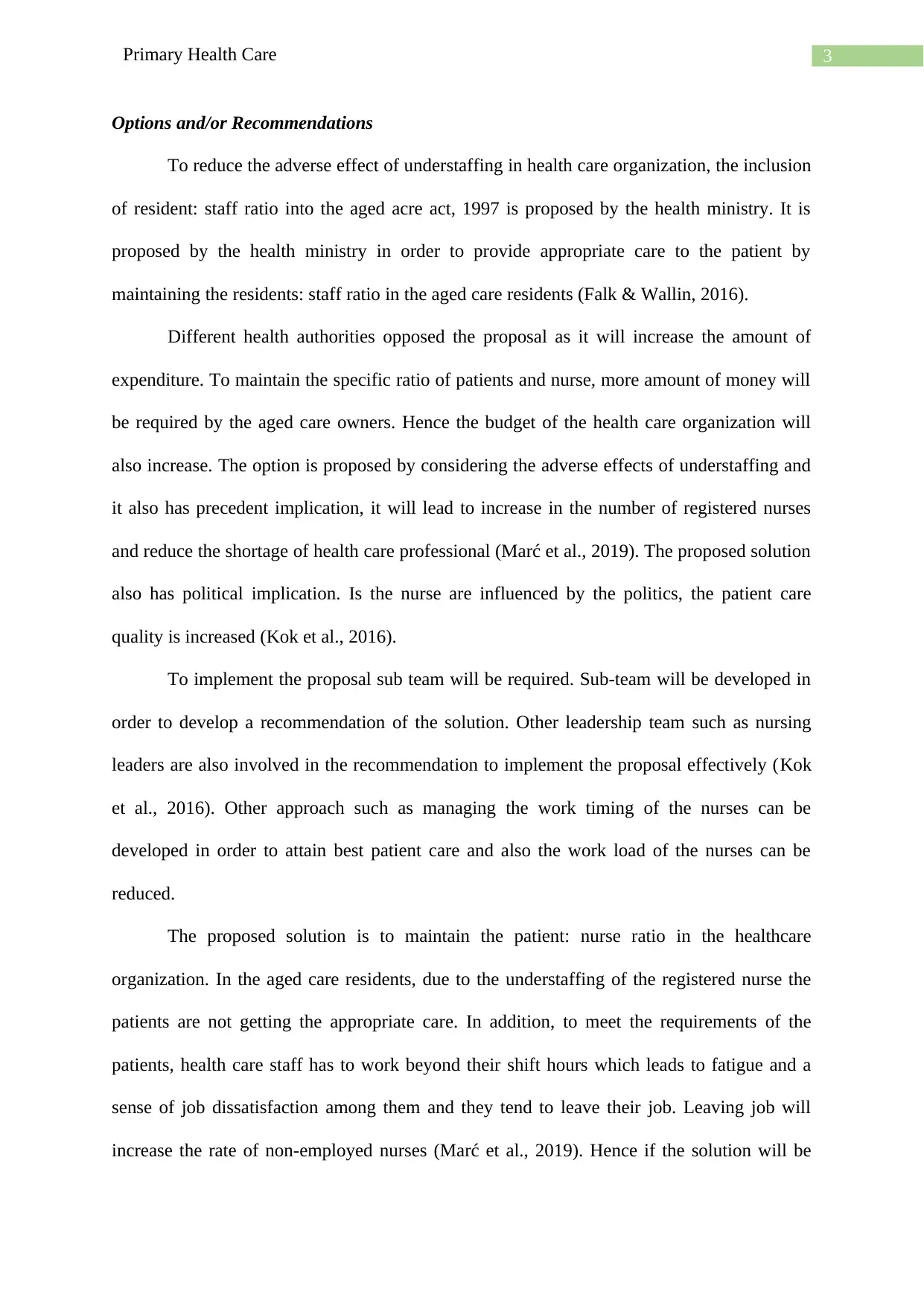
3Primary Health Care
Options and/or Recommendations
To reduce the adverse effect of understaffing in health care organization, the inclusion
of resident: staff ratio into the aged acre act, 1997 is proposed by the health ministry. It is
proposed by the health ministry in order to provide appropriate care to the patient by
maintaining the residents: staff ratio in the aged care residents (Falk & Wallin, 2016).
Different health authorities opposed the proposal as it will increase the amount of
expenditure. To maintain the specific ratio of patients and nurse, more amount of money will
be required by the aged care owners. Hence the budget of the health care organization will
also increase. The option is proposed by considering the adverse effects of understaffing and
it also has precedent implication, it will lead to increase in the number of registered nurses
and reduce the shortage of health care professional (Marć et al., 2019). The proposed solution
also has political implication. Is the nurse are influenced by the politics, the patient care
quality is increased (Kok et al., 2016).
To implement the proposal sub team will be required. Sub-team will be developed in
order to develop a recommendation of the solution. Other leadership team such as nursing
leaders are also involved in the recommendation to implement the proposal effectively (Kok
et al., 2016). Other approach such as managing the work timing of the nurses can be
developed in order to attain best patient care and also the work load of the nurses can be
reduced.
The proposed solution is to maintain the patient: nurse ratio in the healthcare
organization. In the aged care residents, due to the understaffing of the registered nurse the
patients are not getting the appropriate care. In addition, to meet the requirements of the
patients, health care staff has to work beyond their shift hours which leads to fatigue and a
sense of job dissatisfaction among them and they tend to leave their job. Leaving job will
increase the rate of non-employed nurses (Marć et al., 2019). Hence if the solution will be
Options and/or Recommendations
To reduce the adverse effect of understaffing in health care organization, the inclusion
of resident: staff ratio into the aged acre act, 1997 is proposed by the health ministry. It is
proposed by the health ministry in order to provide appropriate care to the patient by
maintaining the residents: staff ratio in the aged care residents (Falk & Wallin, 2016).
Different health authorities opposed the proposal as it will increase the amount of
expenditure. To maintain the specific ratio of patients and nurse, more amount of money will
be required by the aged care owners. Hence the budget of the health care organization will
also increase. The option is proposed by considering the adverse effects of understaffing and
it also has precedent implication, it will lead to increase in the number of registered nurses
and reduce the shortage of health care professional (Marć et al., 2019). The proposed solution
also has political implication. Is the nurse are influenced by the politics, the patient care
quality is increased (Kok et al., 2016).
To implement the proposal sub team will be required. Sub-team will be developed in
order to develop a recommendation of the solution. Other leadership team such as nursing
leaders are also involved in the recommendation to implement the proposal effectively (Kok
et al., 2016). Other approach such as managing the work timing of the nurses can be
developed in order to attain best patient care and also the work load of the nurses can be
reduced.
The proposed solution is to maintain the patient: nurse ratio in the healthcare
organization. In the aged care residents, due to the understaffing of the registered nurse the
patients are not getting the appropriate care. In addition, to meet the requirements of the
patients, health care staff has to work beyond their shift hours which leads to fatigue and a
sense of job dissatisfaction among them and they tend to leave their job. Leaving job will
increase the rate of non-employed nurses (Marć et al., 2019). Hence if the solution will be
Paraphrase This Document
Need a fresh take? Get an instant paraphrase of this document with our AI Paraphraser
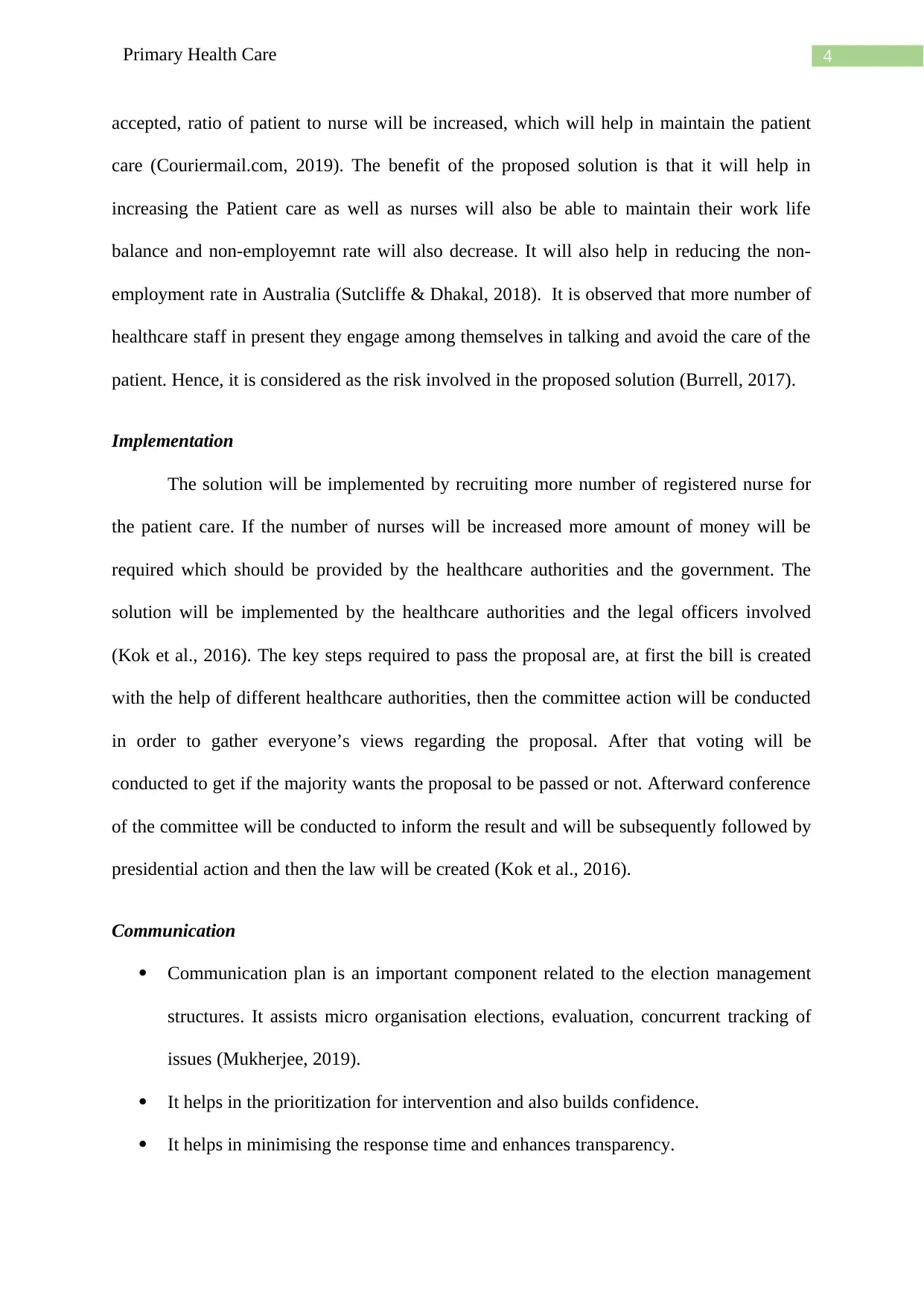
4Primary Health Care
accepted, ratio of patient to nurse will be increased, which will help in maintain the patient
care (Couriermail.com, 2019). The benefit of the proposed solution is that it will help in
increasing the Patient care as well as nurses will also be able to maintain their work life
balance and non-employemnt rate will also decrease. It will also help in reducing the non-
employment rate in Australia (Sutcliffe & Dhakal, 2018). It is observed that more number of
healthcare staff in present they engage among themselves in talking and avoid the care of the
patient. Hence, it is considered as the risk involved in the proposed solution (Burrell, 2017).
Implementation
The solution will be implemented by recruiting more number of registered nurse for
the patient care. If the number of nurses will be increased more amount of money will be
required which should be provided by the healthcare authorities and the government. The
solution will be implemented by the healthcare authorities and the legal officers involved
(Kok et al., 2016). The key steps required to pass the proposal are, at first the bill is created
with the help of different healthcare authorities, then the committee action will be conducted
in order to gather everyone’s views regarding the proposal. After that voting will be
conducted to get if the majority wants the proposal to be passed or not. Afterward conference
of the committee will be conducted to inform the result and will be subsequently followed by
presidential action and then the law will be created (Kok et al., 2016).
Communication
Communication plan is an important component related to the election management
structures. It assists micro organisation elections, evaluation, concurrent tracking of
issues (Mukherjee, 2019).
It helps in the prioritization for intervention and also builds confidence.
It helps in minimising the response time and enhances transparency.
accepted, ratio of patient to nurse will be increased, which will help in maintain the patient
care (Couriermail.com, 2019). The benefit of the proposed solution is that it will help in
increasing the Patient care as well as nurses will also be able to maintain their work life
balance and non-employemnt rate will also decrease. It will also help in reducing the non-
employment rate in Australia (Sutcliffe & Dhakal, 2018). It is observed that more number of
healthcare staff in present they engage among themselves in talking and avoid the care of the
patient. Hence, it is considered as the risk involved in the proposed solution (Burrell, 2017).
Implementation
The solution will be implemented by recruiting more number of registered nurse for
the patient care. If the number of nurses will be increased more amount of money will be
required which should be provided by the healthcare authorities and the government. The
solution will be implemented by the healthcare authorities and the legal officers involved
(Kok et al., 2016). The key steps required to pass the proposal are, at first the bill is created
with the help of different healthcare authorities, then the committee action will be conducted
in order to gather everyone’s views regarding the proposal. After that voting will be
conducted to get if the majority wants the proposal to be passed or not. Afterward conference
of the committee will be conducted to inform the result and will be subsequently followed by
presidential action and then the law will be created (Kok et al., 2016).
Communication
Communication plan is an important component related to the election management
structures. It assists micro organisation elections, evaluation, concurrent tracking of
issues (Mukherjee, 2019).
It helps in the prioritization for intervention and also builds confidence.
It helps in minimising the response time and enhances transparency.
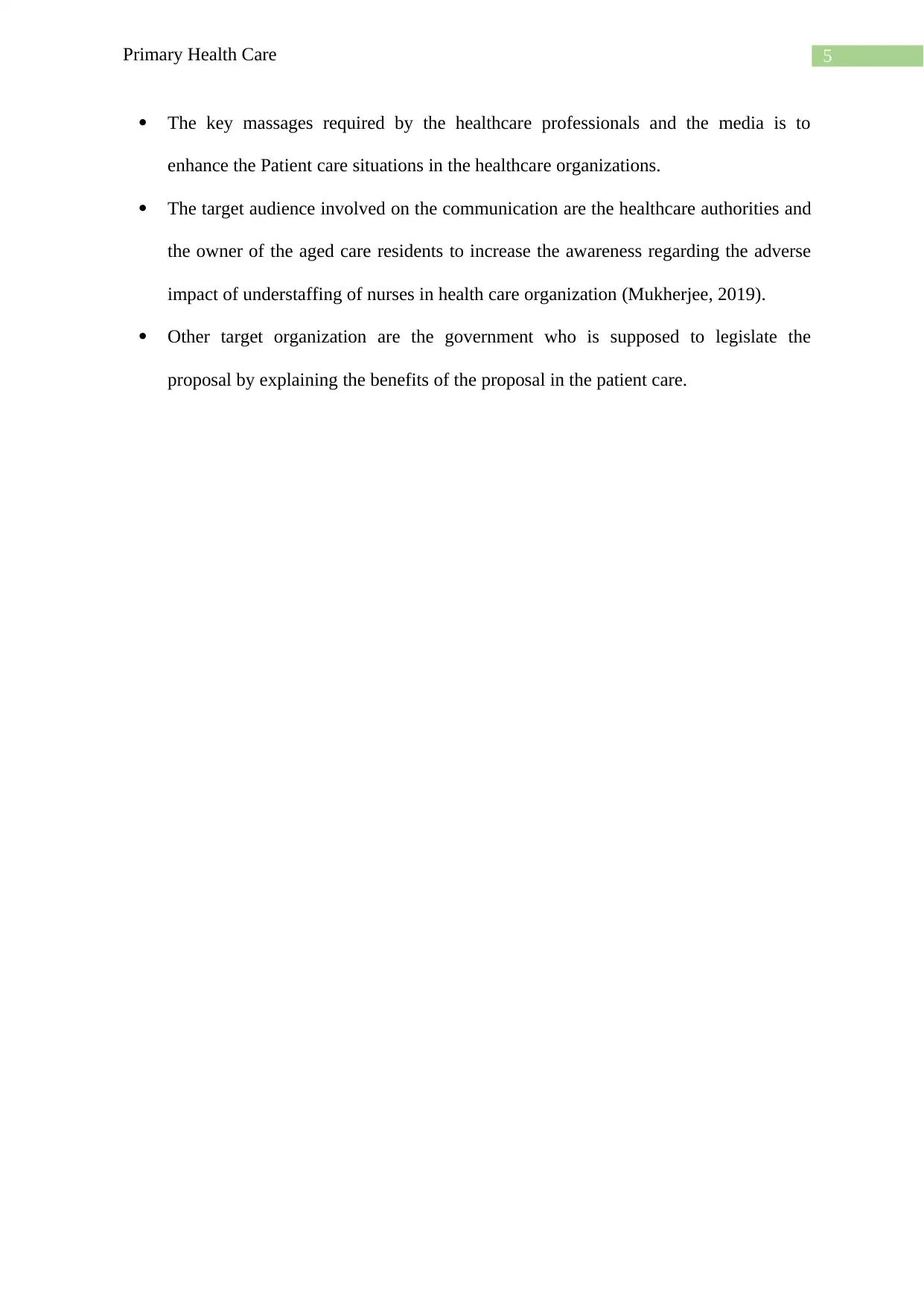
5Primary Health Care
The key massages required by the healthcare professionals and the media is to
enhance the Patient care situations in the healthcare organizations.
The target audience involved on the communication are the healthcare authorities and
the owner of the aged care residents to increase the awareness regarding the adverse
impact of understaffing of nurses in health care organization (Mukherjee, 2019).
Other target organization are the government who is supposed to legislate the
proposal by explaining the benefits of the proposal in the patient care.
The key massages required by the healthcare professionals and the media is to
enhance the Patient care situations in the healthcare organizations.
The target audience involved on the communication are the healthcare authorities and
the owner of the aged care residents to increase the awareness regarding the adverse
impact of understaffing of nurses in health care organization (Mukherjee, 2019).
Other target organization are the government who is supposed to legislate the
proposal by explaining the benefits of the proposal in the patient care.
⊘ This is a preview!⊘
Do you want full access?
Subscribe today to unlock all pages.

Trusted by 1+ million students worldwide
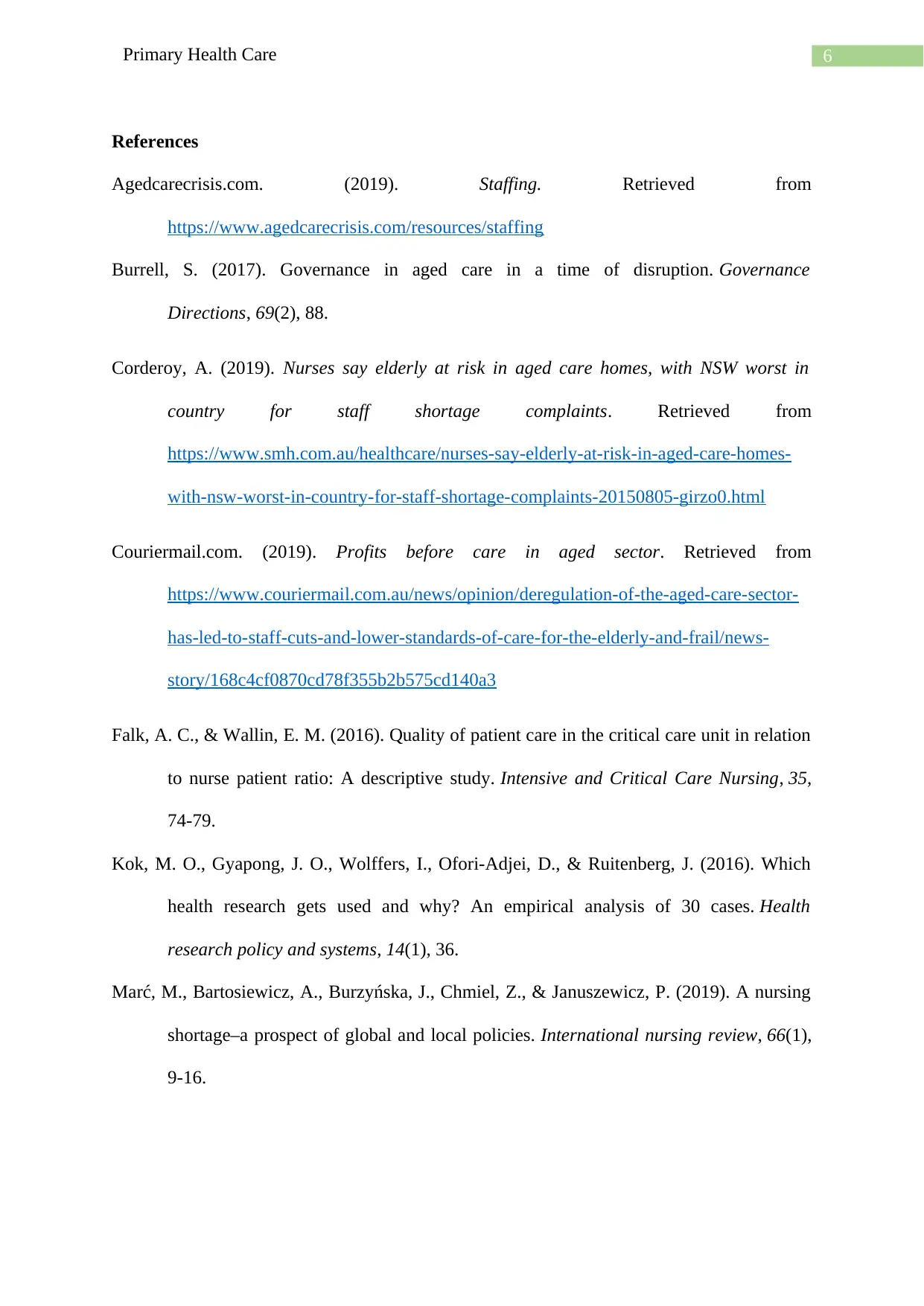
6Primary Health Care
References
Agedcarecrisis.com. (2019). Staffing. Retrieved from
https://www.agedcarecrisis.com/resources/staffing
Burrell, S. (2017). Governance in aged care in a time of disruption. Governance
Directions, 69(2), 88.
Corderoy, A. (2019). Nurses say elderly at risk in aged care homes, with NSW worst in
country for staff shortage complaints. Retrieved from
https://www.smh.com.au/healthcare/nurses-say-elderly-at-risk-in-aged-care-homes-
with-nsw-worst-in-country-for-staff-shortage-complaints-20150805-girzo0.html
Couriermail.com. (2019). Profits before care in aged sector. Retrieved from
https://www.couriermail.com.au/news/opinion/deregulation-of-the-aged-care-sector-
has-led-to-staff-cuts-and-lower-standards-of-care-for-the-elderly-and-frail/news-
story/168c4cf0870cd78f355b2b575cd140a3
Falk, A. C., & Wallin, E. M. (2016). Quality of patient care in the critical care unit in relation
to nurse patient ratio: A descriptive study. Intensive and Critical Care Nursing, 35,
74-79.
Kok, M. O., Gyapong, J. O., Wolffers, I., Ofori-Adjei, D., & Ruitenberg, J. (2016). Which
health research gets used and why? An empirical analysis of 30 cases. Health
research policy and systems, 14(1), 36.
Marć, M., Bartosiewicz, A., Burzyńska, J., Chmiel, Z., & Januszewicz, P. (2019). A nursing
shortage–a prospect of global and local policies. International nursing review, 66(1),
9-16.
References
Agedcarecrisis.com. (2019). Staffing. Retrieved from
https://www.agedcarecrisis.com/resources/staffing
Burrell, S. (2017). Governance in aged care in a time of disruption. Governance
Directions, 69(2), 88.
Corderoy, A. (2019). Nurses say elderly at risk in aged care homes, with NSW worst in
country for staff shortage complaints. Retrieved from
https://www.smh.com.au/healthcare/nurses-say-elderly-at-risk-in-aged-care-homes-
with-nsw-worst-in-country-for-staff-shortage-complaints-20150805-girzo0.html
Couriermail.com. (2019). Profits before care in aged sector. Retrieved from
https://www.couriermail.com.au/news/opinion/deregulation-of-the-aged-care-sector-
has-led-to-staff-cuts-and-lower-standards-of-care-for-the-elderly-and-frail/news-
story/168c4cf0870cd78f355b2b575cd140a3
Falk, A. C., & Wallin, E. M. (2016). Quality of patient care in the critical care unit in relation
to nurse patient ratio: A descriptive study. Intensive and Critical Care Nursing, 35,
74-79.
Kok, M. O., Gyapong, J. O., Wolffers, I., Ofori-Adjei, D., & Ruitenberg, J. (2016). Which
health research gets used and why? An empirical analysis of 30 cases. Health
research policy and systems, 14(1), 36.
Marć, M., Bartosiewicz, A., Burzyńska, J., Chmiel, Z., & Januszewicz, P. (2019). A nursing
shortage–a prospect of global and local policies. International nursing review, 66(1),
9-16.
Paraphrase This Document
Need a fresh take? Get an instant paraphrase of this document with our AI Paraphraser
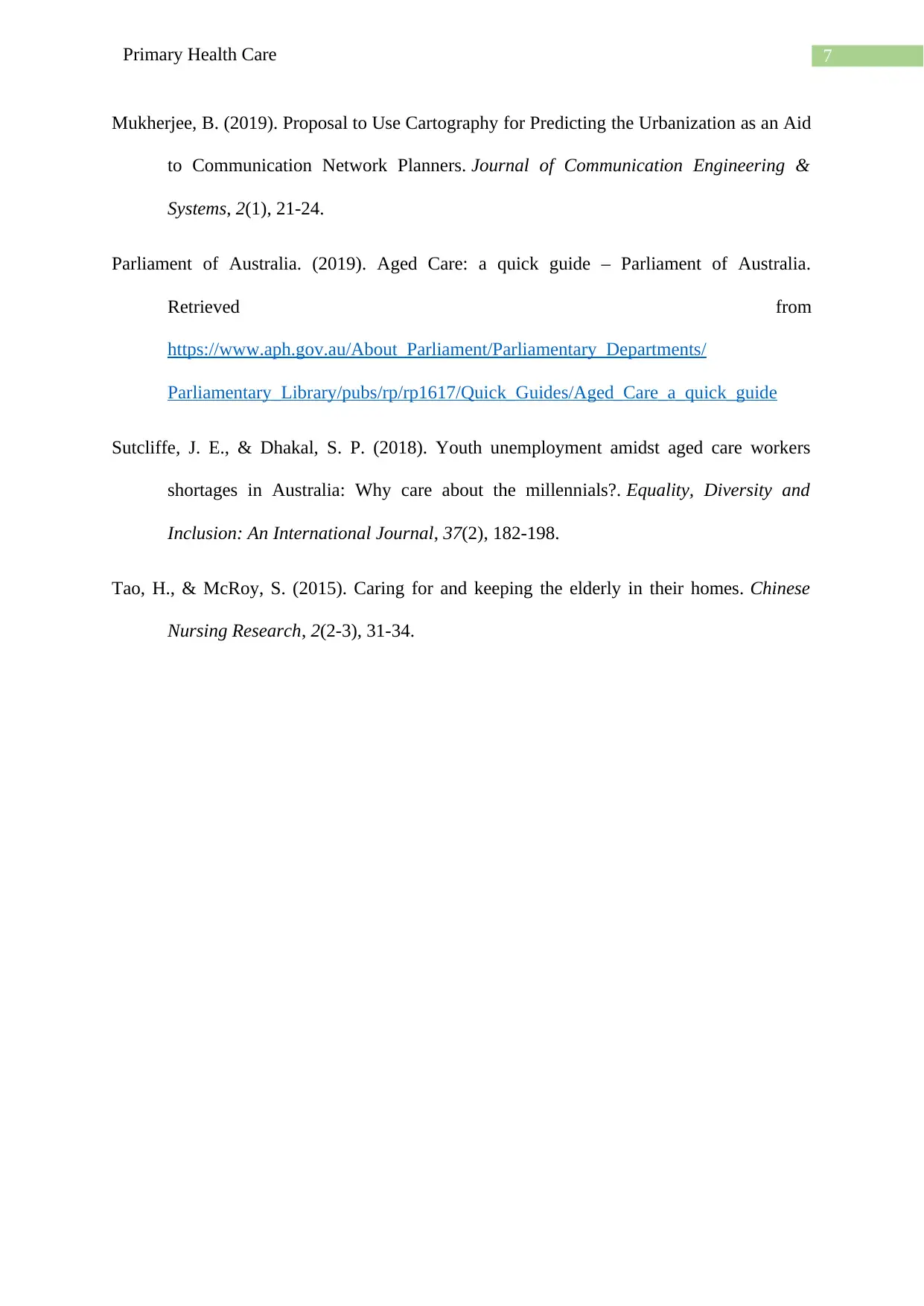
7Primary Health Care
Mukherjee, B. (2019). Proposal to Use Cartography for Predicting the Urbanization as an Aid
to Communication Network Planners. Journal of Communication Engineering &
Systems, 2(1), 21-24.
Parliament of Australia. (2019). Aged Care: a quick guide – Parliament of Australia.
Retrieved from
https://www.aph.gov.au/About_Parliament/Parliamentary_Departments/
Parliamentary_Library/pubs/rp/rp1617/Quick_Guides/Aged_Care_a_quick_guide
Sutcliffe, J. E., & Dhakal, S. P. (2018). Youth unemployment amidst aged care workers
shortages in Australia: Why care about the millennials?. Equality, Diversity and
Inclusion: An International Journal, 37(2), 182-198.
Tao, H., & McRoy, S. (2015). Caring for and keeping the elderly in their homes. Chinese
Nursing Research, 2(2-3), 31-34.
Mukherjee, B. (2019). Proposal to Use Cartography for Predicting the Urbanization as an Aid
to Communication Network Planners. Journal of Communication Engineering &
Systems, 2(1), 21-24.
Parliament of Australia. (2019). Aged Care: a quick guide – Parliament of Australia.
Retrieved from
https://www.aph.gov.au/About_Parliament/Parliamentary_Departments/
Parliamentary_Library/pubs/rp/rp1617/Quick_Guides/Aged_Care_a_quick_guide
Sutcliffe, J. E., & Dhakal, S. P. (2018). Youth unemployment amidst aged care workers
shortages in Australia: Why care about the millennials?. Equality, Diversity and
Inclusion: An International Journal, 37(2), 182-198.
Tao, H., & McRoy, S. (2015). Caring for and keeping the elderly in their homes. Chinese
Nursing Research, 2(2-3), 31-34.
1 out of 8
Related Documents
Your All-in-One AI-Powered Toolkit for Academic Success.
+13062052269
info@desklib.com
Available 24*7 on WhatsApp / Email
![[object Object]](/_next/static/media/star-bottom.7253800d.svg)
Unlock your academic potential
Copyright © 2020–2025 A2Z Services. All Rights Reserved. Developed and managed by ZUCOL.





